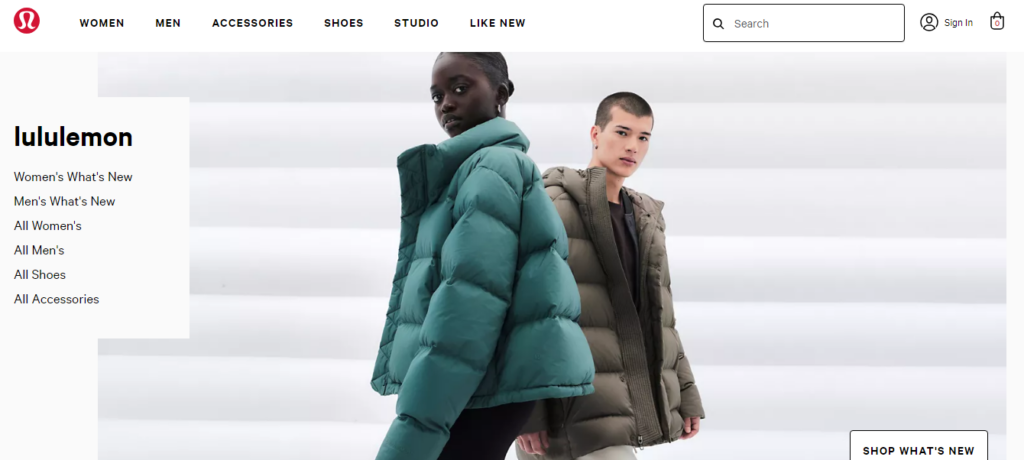Every business has a particular group of individuals who they consider the ideal consumer for their product or service. Lululemon is not an exception in this matter as they also have a particular demography they serve.
Lululemon’s target market comprises females and males who earn a considerable income and are enthusiastic about healthy living through pursuing an active lifestyle.
Lululemon is an athleisure company that began in 1998 to tackle the lack of appropriate yoga apparel at a time when yoga was becoming increasingly popular in Canada.
Over the years, the brand has expanded beyond the retailing of yoga wear to include other athletic and leisure wear. They have also expanded their geographic market beyond Canada to other parts of the world including the United States, United Kingdom, China, Australia, and South Korea.
This means that Lululemon’s target market was initially restricted to yogis, however, the brand’s expansion into the retailing of other athleisure apparel which catered to runners, cyclists, tennis players, and swimmers expanded Lululemon’s target market.
According to the brand’s quarter 2 report for the fiscal year 2023, Lululemon realized a revenue of $2.2 billion, with over 34,000 employees, and 672 stores. Before we discuss Lululemon’s target market, let us define what a target market means.
See also: Lululemon Strategic Sales
What is a target market?
A target market refers to a specified group of individuals or organizations at which a business aims its products, services, and marketing strategies. They are also considered the most suitable and profitable consumer base by a business corporation.
Individuals, groups, or organizations in a particular target market are considered most likely to purchase a product or service. It usually consists of consumers who share similar features such as gender, income, age, religion, career, location, or lifestyle.
A target market is also referred to as a serviceable obtainable market (SOM). It is usually a subset of the larger market for a product or service.
For example, a brand that retails baby formula may choose to market its products to moms instead of parents generally. By targeting their marketing efforts to moms, they leverage the fact that in most homes, mothers are responsible for decisions about the children’s nutrition.

Businesses generally tailor their marketing efforts with the expectations and needs of their customer demography in mind. For instance, when marketing organic foods, retailers often focus on the consumer’s need to access healthier food items, which will enhance their pursuit of a healthy lifestyle.
When a business has more than one consumer segment to which it caters, the consumers will be divided into primary and secondary target markets. For Lululemon, female yogis are its primary target market while women and men that engage in other fitness activities are its secondary target.
See also: Lululemon’s Competitive Advantages and Strategy
Lululemon target market
- Women
- Men
Lululemon’s target market comprises women and men who are conscious about leading a healthy life through being active and getting involved in various physical activities. Lululemon uses different marketing strategies and the marketing mix as a means of reaching its particular target consumers.
The brand is actively involved in engaging with athletes, teams, trainers, and fitness coaches through its community, micro-influencers, and brand ambassador programs. The individuals and teams in these programs provide invaluable feedback to the brand on consumer expectations about its products.
Store employees which the company refers to as educators are also valuable contributors in helping the brand better understand the needs of its targeted consumers through the feedback they receive from shoppers.
The company is equally dedicated to carrying out in-depth research on the best fabrics and designs which will provide the maximum support to Lululemon’s target market. This is achieved by having a team of fabric and design experts who are interested in the sweat life.
The in-depth research provides the fabric and design experts with deeper insights into how the brand’s fabrics and designs combine with its target’s market physiology to support an active lifestyle.
Research also sheds light on the purchasing habits, motivations, media usage, and goals, as well as the most effective marketing and pricing strategies to use.
Let us now discuss the men and women who make up Lululemon’s target market.
Women
When Lululemon was established in 1998, it was inspired by the founder’s discovery of a gap in the yoga wear industry. He noticed that the pants women used for yoga were too thin and became sheer when a person bent over or did some particular poses. This was because there was an unavailability of pants specifically manufactured for yoga. Hence, yogis used pants meant for dancers for their yoga activity.
Chip Wilson decided to fill this lack of appropriate yoga pants by creating yoga pants that were high-quality, thicker, anti-stink, moisture-wicking, and comfortable.
Through Lululemon’s commitment to research, it has been able to create this kind of yoga pants which earned it recognition as one of the best-known retailers of premium yoga pants.
According to the brand’s founder, Lululemon’s target market was Super girls. He explained this target market thus:
I defined a single Super Girl to be 32 years old and born on the 28th of September. I called her Ocean. Each year, since 1998, Ocean never got a day older or a day younger. Every “Ocean” in the world would be our sponsored athlete.
For 22-year-old female university graduates, I posited that their utopia was to be a fit 32-year-old with an amazing career and spectacular health.
She was travelling for business and pleasure, owned her own condo, and had a cat. She was fashionable and could afford quality. At 32, she was positioned to get married and have children if she chose to, and to work full-time, part-time, or not at all. Anything was possible.
For 42-year-old women with two to three children, her former 32-year-old self represented an era when time seemed so available – a time without the pressures of motherhood and when keeping fit was easier.
As my ideal customer and demographic, the 32-year-old in 1998 did not yet exist. In 1998, she was 24. Essentially, I imagined who she would be eight years before her 32-year-old self existed.
I then designed for who I knew she would become in eight years’ time. Because Super Girls were iconic to women of all ages, I felt they would best represent the perfect way to dress for a busy life.
Lululemon Founder, Chip Wilson
The super girls who are Lululemon’s target market had sufficient disposable income, cared about keeping fit, and were willing to pay any amount for the right apparel for their pursuit of an active lifestyle.
The quality and fashionable design of the brand’s products also created a seamless merging of clothes for athletics and leisure. This meant that every Ocean could comfortably wear her yoga wear outside the yoga studio and still look fashionable.
Men
Lululemon’s expansion beyond yoga pants into the retail of men’s wear began in 2014 when the brand introduced its first line of men’s wear. This introduction expanded the target market of Lululemon to include men.
According to a 2015 report by the New York Times Magazine, where the brand’s founder spoke about Lululemon’s target market, the typical male customer for the company is named Duke.
He’s an athletic opportunist who is 35 years old and earns above $100,000 a year. He enjoys snowboarding in the winter and surfing in the summer.
Similar to the women’s target market, Lululemon’s male target market is enthusiastic about keeping fit and is willing to spend on getting the right gear.

See also: Subway Positioning and Marketing Strategies
Who is Lululemon’s target market?
Lululemon’s target market comprises women and men who earn a considerable income, pursue an active lifestyle, and are willing to spend on quality apparel that aids them in achieving this lifestyle.
See also: Digital and Physical Marketing Examples and Differences
Conclusion
Lululemon’s target market initially comprised only of female yogis but has now expanded to include men and other fitness activities. Both the male and female target market of Lululemon share key features in terms of age range, income level, willingness to spend, and the pursuit of a healthy lifestyle by engaging in athletic activities.
Although the above are the main target market of Lululemon, the brand has also diversified into the production of accessories, footwear, personal care items, undergarments, and apparel for teenagers. This diversification has further expanded Lululemon’s target market to include younger and older males and females who are fitness enthusiasts.
The brand’s retailing of other products aside from activewear has also attracted additional customers to the brand who are not necessarily involved in fitness activities but want high-quality everyday wear.
The apparel made by Lululemon has been associated with being able to withstand the rigors of different fitness activities including yoga, swimming, running, hiking, cycling, and tennis. It is currently one of the biggest athleisure brands in the world.
Last Updated on November 2, 2023 by Nansel Nanzip BongdapBlessing's experience lies in business, finance, literature, and marketing. She enjoys writing or editing in these fields, reflecting her experiences and expertise in all the content that she writes.

